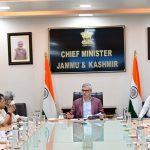SYED MOHMAD SHAH AAFTAB | PARVAIZ AHMED RESHI
Kashmir valley provides lucrative drivers for establishment of commercial dairying, whether social, political, cultural, economical or environmental. Population growth, urbanization, emerging middle class, pressure on land and social tensions around youth unemployment rates provide the much-needed demographic drivers, while loss of agro-biodiversity, in this otherwise bio resource rich Himalayan valley, shrinking water resources and climate change provide the compelling environmental drivers. Taken together, these drivers provide the most suitable and conducive time to plunge into commercial dairying and take the farming community out of the limitations posed by conventional dairying.
The scenario demands an immediate answer to questions that could be framed as “hang in” or “step out” regarding dairy farming and the immediate and sustainable answer seems to be “step up” to commercial dairying. To provide step-up roadmap, strategies for building a comprehensive and cohesive environment are to be designed and tailored regarding:
- The Enabling environment of regulations, services, infrastructure, standards, and institutions.
- The Food environment demands for preservation of the cultural/ health environment that determines dairy as part of local diet.
- The Business environment demands for availability of inputs and services, affordable and of good quality, to operate the dairying business in a space that is safe, bio-secure and bioactive.
- The Consumer environment demands for shaping the market demand by highlighting the nutrition and safety consciousness of the product.
Taking its uniqueness and reputation together with human resources at hand, SKUAST-Kashmir seems to be the main institution in the region that could provide the roadmap and necessary power for building and sustaining all the four enabling environments for commercial dairying. Its Mountain Livestock Research Institute at Mansbal needs to be upgraded into a Commercial Dairy Model Institute and business unit with sub-units in other districts, as and where needed, for procuring the raw milk at reasonable prices, its methodological transportation, processing, quality control, packaging, value-addition and marketing under its name.
In addition, it should provide necessary R&D facilities for the farming system, which is much broader than just dairy production, for it integrates crop-livestock combinations, farm sizes, herd composition, livestock breeding, reproduction, conservation and propagation of elite animals, as well as market-participation level, off-farm employment, nutrient cycle and sensitivities of bio-resource rich Himalayan region and mountain agriculture. It must focus on all the leverage factors that shall expedite commercial dairying in the region. A recent development in this regard is the proposal for establishment of MOET-IVF facility at MLRI for rapid propagation of the elite germplasm to be imported under the project for strengthening dairy sector in UT of J&K. Some of these leverage factors, in perspective of the valley, include:
Right trade and investment policies
An important and key component in sector transformation from conventional to commercial dairying demands right and region-specific policies that focus on:
- Consistent availability of dairy products for consumers at the reasonable prices
- Provision for right incentives for farmers/producers, processors, and service providers.
- Tailoring and designing of infra-structure and special investment facilities in areas where the long-term potential (Source areas) and establishment of marketing facilities in areas where the long-term demand justifies so.
- Special policy for urban and peri-urban areas in view of increasing land prices, high dependency on purchased roughage and concentrates and the increased pollution caused by dairy farms.
Sustainable intensification
The strategies need to be developed where Dairy can outcompete other cash crops, keeping in view the shrinking land for fodder production and the competition which dairy has to face for its food and space with both humans and other animals like poultry. This demands transition from low input-low output-low risk strategy to high productive systems where more milk is produced by less cows. The strategies for this transition in the ecologically sensitive Kashmir valley need to be framed out. The case of valley is again different regarding a wholesome intensification drive which can be counterproductive. In our scenario, priority may be given to upgrading the low input-low out-put-low risk (Step-up) and small-scale dairy farming systems through testing and supporting pathways towards productive, commercially viable and sustainable systems. In the in conducive environment of the valley, supporting intensification should go hand-in-hand with improving the market conditions and delivery of services.
Fodder, Genetics and Manure
Under the Kashmir scenario, the central theme in supportive intensification should be on feeding, where it must be realized that energy and protein from good quality roughage would be cheaper than from concentrates. The relevant institutions need to come up with new and superior varieties of fodder crops that are draught-resistant, easy to conserve, climate resilient and affordable to farmers. The easier and sustainable ways of fodder preservation and quality enrichment, like silage making, need to be developed and disseminated into the farming community.
A proper region-specific genetic profile of the dairy herd needs to be established, conserved and propagated for which studies and research, together with exploitation of the modern Assisted Reproductive Technologies which would enable rapid propagation of the selected breed in the region need to be conducted. Dairy breeding policy needs to be developed based on agro-ecological conditions, management and available feed rations, contrary to a single breeding policy for the entire region. Improvement in manure management is crucial to contribute strengthening the farming system and soil fertility.
Safe milk and other dairy products
Milk composition and milk quality are the final determinants of its market acceptability and all provisions that would ensure safe milk to the consumer need to be taken into consideration. Modules should be developed for quality-based milk payment system. Investments need to be made in milk testing equipment, additional operational costs, calibration services, etc. Further provisions for training and coaching of farmers and capacity building of milk transporters and milk operators/processors needs to be provided.
Training, education and extension
Programmes and training courses need to be devised to create a dairy-technocrat who shall be the future dairy professional with the necessary knowledge to indulge in profitable and socially-beneficial dairying. A dairy education platform where government, knowledge institutes, civil society, private sector and farmer organizations co-operate for the Blended learning are the need of the hour.
Inclusiveness and delivery of inputs and services
The Kashmir scenario demands that small holder farmers, including women and youth, be embedded and fostered in the dairy sector. In Kashmir about 70-80% of the primary producers are small-holders who are not well represented in management and producer organizations. The situation demands development of inclusive business models that offer small-holders:
- Access to inputs like feed, fodder, medicines and equipment.
- Access to services like veterinary care and artificial insemination.
- Extension and financial support.
Development of specific dairy zones
Since, the valley exhibits huge geo-climatic variation, it is perceived that different regions are naturally suited for rearing of different cow breeds, which produce milk of varied composition, quantity, quality and usefulness. Identification of the regions for development as specific dairy production zones for a specific dairy product or milk quality need to be done. A GI could be achieved for these zones so that the dairy product targets and receives a different market. Focus should also be on preserving and strengthening the natural breed and fodder interaction in these special zones.
(Syed Mohmad Shah Aaftab is Assistant Professor, MLRI Manasbal, SKUAST-Kashmir and Parvaiz Ahmed Reshi is Assistant Professor, Division of Animal Nutrition, SKUAST-Kashmir. Email: [email protected])








